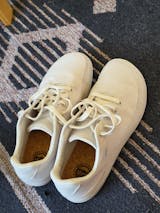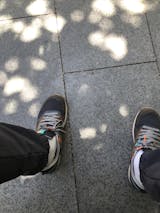Correct Toes - Toe Spacers for Natural Alignment & Foot Health
Restore your foot’s natural shape — discover how toe spacers (also known as toe separators) can help your feet move, balance, and function the way nature intended.
Unfortunately modern footwear typically squeezes the toes together, weakens foot muscles, and disrupts your body’s alignment. Toe spacers gently restore natural toe splay — improving stability, comfort, and mobility from the ground up.
Whether you’re recovering from foot pain or simply aiming to improve your posture and balance, the right pair of toe spacers can make a lasting difference for your long-term foot health.
Why Use Toe Spacers or Toe Separators?
Most modern shoes are too narrow to support the natural shape of our feet, often with raised heels and rigid soles that further force our toes together. Over time, this unnatural position can lead to bunions, hammertoes, neuromas, plantar fasciosis, and even knee, ankle and hip pain.
Toe spacers work to gently correct these issues by:
-
Restoring natural toe alignment
-
Improving balance and posture
-
Reducing pain and pressure in the feet and joints
-
Encouraging proper muscle function and circulation
-
Supporting long-term mobility and comfort
Wearing Correct Toes toe separators consistently can help you reverse damage caused by years of restrictive footwear naturally — without surgery or medication!
Correct Toes: Designed by Podiatrist Dr. Ray McClanahan
Dr. Ray McClanahan, a natural sports podiatrist, developed Correct Toes to help his patients reverse the damage caused by modern shoes and heal foot pain at the source by restoring natural alignment.
Watch the short video below where Dr. Ray explains how Correct Toes work and why thousands of people around the world trust them to restore healthy foot function.
Common Foot Problems Helped by Toe Spacers
Many foot ailments can be prevented or improved by simply giving your toes more space and supporting natural alignment. Correct Toes toe separators have been shown to help with:
-
Bunions & tailor’s bunions
-
Hammertoes & claw toes
-
Morton’s neuroma
-
Plantar fasciosis (chronic plantar fasciitis)
-
Hallux limitus & rigidus
-
Ingrown toenails & corns
-
Heel pain, capsulitis, and metatarsalgia
-
Poor balance or gait issues
These improvements often extend beyond the feet — users have also experienced less knee, hip, and lower back pain as their posture and biomechanics naturally improve.
Barefoot vs. Conventional Footwear
Cultures that go barefoot or wear minimal shoes throughout life rarely develop the foot problems seen in industrialised countries. This is because their toes remain spread, strong, and functional.
Conventional footwear, on the other hand, elevates the heel, narrows the toe box, and bends the toes upward. Over time, this alters foot shape, weakens muscles, and disrupts balance and movement patterns.
Correct Toes toe spacers are designed to undo this damage, helping your feet return to their natural, wide, stable shape — the foundation for healthy movement.
Benefits of Correct Toes Toe Spacers
-
Correction of: bunions, hallux limitus and rigidus, tailor’s bunions, corns, ingrown toenails, heel pain, plantar fasciosis, neuromas, capsulitis, lower leg pain, and runner’s knee. No surgery or medications required!
-
Better balance in athletes, Parkinson’s patients, and elderly.
-
Decreased injury rates in athletes, due to allowing the body to make better use of natural physiological adaptations that are hampered by the current footwear available to athletes.
-
Increased performance in athletes (especially walkers and runners) by promoting foot positions that scientific studies have shown to have a 4 to 5% performance edge. Learn more about the benefits of Correct Toes Toe Spacers for running & athletic training here.
-
Improved strength and flexibility of the toes. This enhances proprioception, and subsequently, the brain signals the body to move forward more naturally.
-
Less osteoarthritis (also known as degenerative arthritis), currently plagues a majority of senior citizens, as well as a high percentage of the younger population.

Benefits of Correct Toes Toe Spacers: Real Results
“My plantar fasciitis progressed to plantar fasciosis and caused knee and hip pain. After using Correct Toes, toe socks, and transitioning to minimalist shoes, I’m almost completely healed — it took about two years, but it was worth it!”
- Charles R.
People around the world have used Correct Toes toe spacers to transform their foot health naturally — without surgery, orthotics, or medication.
How to Use Correct Toes Toe Spacers
Start slowly, and build up gradually over time as your body adjusts. Wear your Correct Toes toe spacers:
-
For short periods at first (start with 30 minutes a day)
-
Barefoot, underneath regular socks, or over toe socks.
-
With barefoot shoes or wide toe box footwear
Why Choose Correct Toes Toe Spacers over other brands?
✅ Designed and recommended by podiatrists
✅ Medical-grade silicone — comfortable & durable
✅ Wearable in shoes, with socks barefoot
✅ Made to last
✅ 30 day “no worries” return policy
30 Day Worry-Free Returns
We are so confident in this amazing product that we offer a 30-day-no-worries return policy for Correct Toes, with a 90-day materials warranty if they split or break during use. You may also return Correct Toes within 30 days, even if they have been used or modified.
⚠️ Warning, Please be aware of cheap imitations which are not Podiatrist-approved and are not Authorised Correct Toes retailers. These may do more harm than good! ⚠️


























